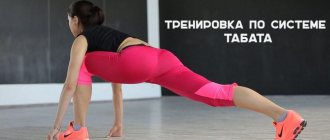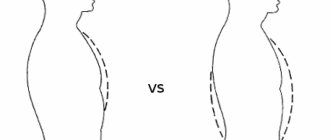Good day, dear friends! You've probably already read our previous article about the optimal number of repetitions for growth. If yes, then great, let's move on! Well, if not, then be sure to read it to have a complete understanding of such an important issue as training intensity. So, let's go!
In the last issue about the number of repetitions per mass, we came to the conclusion that for better muscle fiber growth, two mandatory components are needed - myofibrillar hypertrophy (growth of contractile fiber structures) and sarcoplasmic hypertrophy (increase in sarcoplasm due to an increase in the amount of non-contractile proteins and energy structures) .
In general, to put it in simple terms, to grow muscles you need to simultaneously train both the strength and the energy component of our muscles.
We also concluded that in order to accumulate certain factors in the muscles that activate muscle growth, it is best for us to achieve muscle failure within 30 seconds in each working approach, which is equivalent to 6-12 repetitions.
Why do we emphasize the phrase “working approach”
— The point is that you need to distinguish working approaches from warm-up ones.
When performing a warm-up approach, we work with light weights and do not achieve muscle failure. We need warm-up approaches, firstly, to properly warm up our muscles and prepare them for work. Secondly, when performing a series of warm-up approaches with light weights, our muscles seem to remember the trajectory of movement, and, thereby, we establish a connection between the brain and muscles, improving muscle coordination.
Well, working approaches (sets) are those that are a series of those same 6-12 repetitions to failure. Yes, by the way, we will count approaches regardless of the exercises themselves.
The fact is that only we know that we perform different exercises for the same muscle group. And our muscles don’t care what they do, for example, bench press or dumbbell press.
The muscle simply contracts when we tell it to, and that’s it! Therefore, our muscle doesn’t care whether you do 3 exercises of 2 approaches, 2 exercises of 3 approaches or 1 exercise of 6 approaches.
Today we will talk specifically about the total number of working approaches per muscle group, regardless of the exercises. In practice, you can even choose one of your favorite exercises for a specific muscle group and do only that one if you think it is the most effective.
As with the number of repetitions, the number of sets themselves depends very much on the goal of your training.
Why follow the rules
You can watch how beginners perform 10-12 working approaches, literally “killing themselves” in the gym. Does this make them more physically fit? It’s unlikely, usually those who like to pump their biceps in 10 approaches are left with arms like branches until a competent trainer sets them on the right path.
Important: the training process must be periodized. Macroperiodization is the division of training depending on the global goal. A macrocycle in fitness can be aimed at practicing technique, reducing body fat, gaining muscle mass, or general weight loss and developing healthy habits. Depending on the purpose of the macrocycle, mesocycles, that is, training months, are built. And they describe the set-repetition schemes in the microcycle, that is, the number of “sets and repetitions” of each exercise
You need to understand that all these rules were not invented by some athlete based on his experience. They are scientifically based, and came from the methodology of a slightly different sport - weightlifting. The closest thing to fitness is load planning in bodybuilding. But the methodology of this sport is greatly influenced by such factors as the use of pharmacology. You can talk as much as you like about the fact that bodybuilding requires first hard work, and then doping, but the latter changes a lot. The athlete recovers many times faster, his physical capabilities are higher than those of an ordinary person. This is where the terrible drop sets of 6 “drops” of weight come from, and workouts that load one muscle group in 10 exercises and 5 working approaches.
Professionals use the categories “time under load,” “training volume,” “training intensity,” and “rest time.” The most important for us are the second and third criteria if the goal is to transform the figure. Volume is the total number of repetitions in all working sets. When it comes to muscle hypertrophy, there is no point in exceeding 32-36 repetitions.
With such a volume, the intensity, that is, the working weight, cannot be very high. In sports terms, “very” is 80-90% of the one-repetition maximum in an exercise. For muscle building purposes, it makes sense to train in the 70 to 80% range.
If you are talking about “losing weight”, that is, burning fat and maintaining muscle mass, you will need to reduce the volume to about 16 repetitions in total, but do not reduce the intensity. These rules apply to basic multi-joint exercises. “Isolation” can be subject to others.
Strength training, aimed at developing only physical quality - strength, is performed in a volume of 15 to 25 repetitions. With good recovery abilities, the volume can be increased to 36 repetitions, but no more.
Another factor that matters is the rest time between working sets. For non-strength training, resting 60 to 120 seconds between sets is optimal. Powerlifting-style strength training may also require more rest time.
This is in theory, but in practice a variety of layouts are possible. In practical training, such a factor as the overall recovery of the athlete is important. Therefore, approaches and repetitions may vary individually.
How many sets and reps to do?
Second training option
When you do a large number of working sets (20 or more) with minimal rest between them. In this case, you achieve serious sarcoplasmic hypertrophy by increasing the amount of energy components in the sarcoplasm of the muscle fiber. You also become quite resilient compared to powerlifters, because... “sharpen” your muscles for high-volume work. The next advantage of such training is that with a short rest between approaches (30-45 seconds), a maximum release of anabolic hormones (testosterone, growth hormone) is observed. But!
There is one very important disadvantage
In order to work at such a volume, you are simply forced to work with small working weights. This means your strength will leave much to be desired.
In principle, if you have more or less good genetics, then you can significantly gain weight by training in this mode.
However, imagine that someone invites you to arm wrestle or compete in some kind of power dispute! And modern lazy people only need this, to prove the “weakness” and “uselessness” of large muscles.
As in the article about repetitions, for muscle growth and strength we suggest you some intermediate option - approximately 8-15 approaches per muscle, with a rest of 60-90 seconds between them.
By training in this mode, you achieve both myofibrillar and sarcoplasmic hypertrophy. Consequently, you can do a fairly serious amount of work with far from small weights, because... rest more than with a conventional high-volume system.
In other words, by training in this way, you will develop strength, endurance, and muscle mass. This is the most versatile option that will suit the vast majority of trainees.
But there is one “BUT”!
The training option proposed above is suitable for more or less prepared guys. If you are just starting to train, then 3-5 approaches per muscle group will be enough for you.
Gradually, as you progress, you will understand when you need to increase the number of approaches. The main thing is not to overdo it! If you do too many sets during a workout, your muscles will simply refuse to grow due to the enormous stress.
Remember! You should regularly place stress on your muscles, but this stress should not be too excessive.
Increase the weights little by little, even if you feel that today you will bench press 5 kg more than in the last workout, under no circumstances do this!
It is better to add 1 kg in working weights for 5 workouts than to add 5 kg for 1 workout. In total you will get the same amount, but in the long run you will achieve much more.
The same rule applies to increasing the number of approaches and repetitions. Believe me, it’s better to undertrain a little than to overtrain and start all over again.
The number of approaches also depends on the size of the muscle group being trained. It's logical to assume that you'll need more sets to train your back or legs than, say, train your arms.
Beginners generally don’t need to train their hands in the first few months, because... they will grow on their own. But if you really want it (how could you do without it), then 2-3 working sets for biceps and triceps will be enough for you.
Different goals - different number of repetitions
How to write "layouts"? Based on general information:
- To develop strength, perform from 1 repetition to 5-6 per set . Strength training is the most “precise”; it does not allow the athlete to exercise “intuitively” in most cases, and does not require performing work to failure. Strength training involves performing 4-6 reps at 70 percent of your one-rep maximum, triples at 80 percent, and doubles and singles above. In this case, “technical one-rep sets” are used, when the athlete performs work for 1 repetition with a lighter weight, which he can lift for 4-6 repetitions. The difference here is that each repetition is performed in a competition technique, that is, from the starting position as at the beginning of the set, and not, as in bodybuilding, from a position in which the joints can be slightly bent;
- For hypertrophy, that is, muscle growth - from 6 to 12 repetitions . The data varies in the sources, the “golden mean” here is to do the exercise at a normal pace, and try to time how many repetitions will be completed in 30 seconds. This is approximately what a beginner needs for hypertrophy. More experienced ones can go up to 40 seconds and near failure repetitions;
- Those who are losing weight don’t need a lot, we’ve already found that out . But bodybuilding sources insist they do 15-20 reps. It doesn't really make much sense in a fitness situation. Most non-professional athletes find it difficult to maintain a safe starting position. They seriously break equipment and can get injured. Or another option is to do “aerobics with dumbbells,” that is, they perform power movements with minimal weight, and are unable to preserve muscles because of this. To ensure fat burning and not provoke muscle breakdown, it is still recommended to do two to three six-repetition strength sets of basic exercises at the beginning of your workout. And after that you can do whatever you want, for example, 20-repetition dumbbell aerobics.
The most important problem for a fitness specialist is an adequate choice of weights. Some tend to under-train, while others take each set too close to failure and overtrain. Still others avoid normal barbells and dumbbells altogether, and, being healthy, for some unknown reason, work out with elastic bands or something similar.
Ideally, you need to make at least an “estimate” in threes and calculate your RM in basic exercises from it. But those who are afraid of lifting heavy can do one “failure” approach with regular weights, find a 1 RM calculator on the Internet.
It is better to follow the percentages indicated above and lift working weights in proportion to the increase in strength, and not as you please. The approach where in one workout a person lifts 100 kg in squats, and in another with terrible technique he tries to stand up 150, because the girl of his dreams came to the gym, is not acceptable when it comes to fitness for health.
How many reps do you need to do to grow muscles?
First training option
If you are training strength, then you need to do few sets (5-8 per muscle group) with heavy weight and rest between sets (3-5 or more minutes).
Why rest for so long, because muscle energy will fully recover much faster?
The fact is that for the best training of myofibrils, we need to work with heavy weights in several approaches. And we remember from the previous article about repetitions that during the breakdown and resynthesis of ATP, our muscles become highly acidified (H3PO4 and Lactic acid).
Increased acidity in the muscles does not allow further work with heavy weights, therefore, on the one hand, it is very important for powerlifters to wait until the acids in the muscles “resolve.”
On the other hand, the main source of energy resynthesis for powerlifters is creatine phosphate and, to a lesser extent, glycolysis. And it takes a few minutes to restore creatine phosphate reserves.
This is why powerlifters rest for at least 3 minutes before lifting heavier weights again!
With this option, we thoroughly train myofibrils (contractile elements of muscles), but pronounced sarcoplasmic hypertrophy does not occur, therefore, endurance is poor.
And we remember that for maximum muscle growth we need to achieve both myofibrillar and sarcoplasmic hypertrophy.
Ultra-Volume Workouts
Imagine a long distance runner. He needs leg strength and sufficient power to work. But he doesn’t need to carry 100 kg of muscle mass on himself at all. Ultra-volume training is used when you need to develop strength endurance and the ability to function effectively under prolonged, repetitive load.
This option can use training schemes with 1, 2 or more minutes under load. A similar methodology is used to train for weight loss with mini-barbells – Hot Iron and Body Pump.
Various methodological techniques can be used:
- To develop strength endurance, for example, for middle-distance running, long sets with long rest can be used;
- “Losing weight” is usually prepared using various pyramids, “ladders”, and other techniques that allow you to increase the number of repetitions in the approach and extend the time under load
Why do you need to do repeated tests for coronavirus?
Detailed explanations about the system adopted in Russia for testing patients with Covid-19 have appeared on medical websites. In them you can find an explanation of the need to correctly conduct research if you suspect a dangerous infection. This is a necessary procedure that is important in diagnosis and helps determine the presence of a pathogen in the body in different cases, with varying needs:
Approaches
How many approaches should you do? There is a rule of 12 - one muscle group should not have more than 12 working approaches in total. This applies to both losing weight and gaining weight. For strength training, such rules do not work; there the load is measured in KPS, that is, the number of lifts of the barbell, and individual characteristics are taken into account. There are athletes who are not suitable for volume training, but there are also those who cannot train intensively and are forced to constantly adhere to medium intensity and high volume with rare peaks.
In practice, the following schemes are used:
- 3-12 approaches for strength training;
- 3-4 for hypertrophy and fat burning;
- “Cross-training” and circuit training schemes for increasing strength endurance
conclusions
Let us emphasize the main thing - you should not do more than 3-4 working approaches, remember! you must invest 45 minutes in training, before working approaches, be sure to warm up your muscles, as well as stretching, and also learn how much rest you need between approaches and what to do between approaches.
By applying all this knowledge in combination, you will achieve new results, where previously you thought there was a dead end from which there was no way out. Train, work on yourself, learn new techniques and see how you become one step closer to your ideal figure - good luck to you guys











